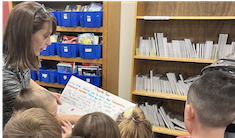We’ve found something we now call the happiness advantage, which is when the brain is positive, it has an unfair advantage over the brain that is negative, neutral, or stressed.
—Shawn Achor
My brain has been feeling incredibly stressed. I did my second round of cancer treatment during the heat of the pandemic. Feeling unsafe for so long has thrown my brain for a loop. I felt the disadvantage of a stressed brain—and sometimes still do. I was amazed as I learned that Shawn Achor’s research suggests we can rewire our brains in as little as 28–30 days. We can grow our optimism, increase our positive emotions, change how we view and manage stress, and help others do the same.
I’m not the only human experiencing stress. My kindergartners manage their own stress: Who’s going to play with me on the playground? Is my friend still my friend? Can I really do what I need to do in school? How will I survive without my family all day long?
I want the happiness advantage for me, and for my students.
Achor says we can increase our levels of happiness by embracing habits of gratitude, reflecting on positive experiences, exercise, breath and meditation, acts of kindness, and changing how we view stress. (For the complete article, read the Harvard Business Review: “The Happiness Dividend.”)
I wondered…
- How might I put the things that Shawn Achor talks about into a formula that five- and six-year-olds would understand and use?
- How might I help them have some points to return to time after time that would allow them—no matter the situation—to construct a reality with a greater positive outlook and understanding?
- How might I help my kindergartners have a few go-to thoughts they can rely on to help them construct an accurately positive understanding of themselves and the world around them?
I identified several classroom routines that I could adopt—or adapt—that would give my kindergartners the exposure needed to rewire their brains for greater happiness. I decided to start with our classroom jobs and power leads.
Classroom Jobs
I crafted all my classroom jobs to be more closely aligned to creating positivity and peace. I purposefully embedded phrases, breath, and agency into them to give my kindergartners a daily dose of positivity. Two that are particularly grounded in positivity and peace are our Positivity Proclaimer and our Peace Person.
Our Positivity Proclaimer creates three positive statements that are true about us. She proclaims them during our morning meeting, pausing for her fellow learners to repeat each statement and claim it as their own. Some days the Positivity Proclaimer’s words mirror mine, and at other moments they are totally crafted by the kindergarten leader.
Our Peace Person invites us to put our hands on our hearts and leads us in three collective breaths. She instructs us to breathe in through our noses and out through our mouths. She then leads us in four peaceful statements: “I am safe. I am loved. I am peaceful. Life is good.” I crafted these affirmations to combat the fear many kindergartners bring with them to our learning space.
Power Leads
We regularly use modified power leads as we begin our day and our various learning moments. Power leads are positive statements we make that have the potential to influence the direction of our day, our conversations, our experiences, and our learning. Our power leads include reminders and recollections of truths about our greatness. We have four regular ones: Affirmations, Our Math Shake, Our Reading Shake, and our TA-DA lists.
Our affirmations began with two simple phrases. I have a big, beautiful brain. I have an awesome heart. Since their inception, I have added others that I hope and believe help my kindergartners wire their brains for happiness and success. I am brave. I am kind. I can do hard things. I am fantabulous.
Our math and reading shakes include counting, doing math, or spelling while shaking our arms, legs, and bodies. They are a fun way to practice number facts and sight words. The power lead actually happens several times during the shake. To complete a round we all proclaim, “We are mighty mathematicians!” or “We are remarkable readers!” The kindergartners think deeply as they spell or do math, giggle along as we shake, and then proclaim the power lead with gusto.
Our TA-DA lists are a way to accomplish our to-do lists with a sense of celebration. These are not lists of the many things we must do. Instead, they are a place for us to record what we’ve done. They are then a record we return to, to celebrate all we’ve done, all we’ve learned, and all we are. TA-DA!
I am still managing the effects of stress, but each time I engage in these practices with my kindergartners, I feel a bit of my stress ease and a bit of my positivity return. My kindergartners, too, seem to be moving about our space with more peace. One, who adamantly said in the beginning of the year, “I CAN’T read!,” now smiles as she shares her books with me. The other day, she whispered, “I can read, Miss James.” Indeed, many brains are being rewired.





